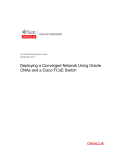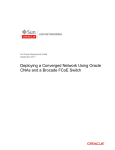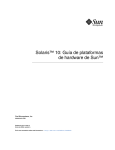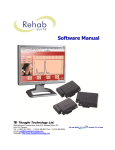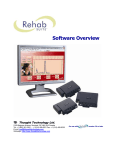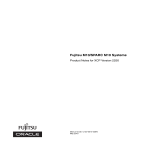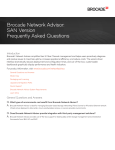Download - Oracle Documentation
Transcript
SPARC T5-4 Server Product Notes Part No: E29661-13 October 2015 Part No: E29661-13 Copyright © 2013, 2015, Oracle and/or its affiliates. All rights reserved. This software and related documentation are provided under a license agreement containing restrictions on use and disclosure and are protected by intellectual property laws. Except as expressly permitted in your license agreement or allowed by law, you may not use, copy, reproduce, translate, broadcast, modify, license, transmit, distribute, exhibit, perform, publish, or display any part, in any form, or by any means. Reverse engineering, disassembly, or decompilation of this software, unless required by law for interoperability, is prohibited. The information contained herein is subject to change without notice and is not warranted to be error-free. If you find any errors, please report them to us in writing. If this is software or related documentation that is delivered to the U.S. Government or anyone licensing it on behalf of the U.S. Government, then the following notice is applicable: U.S. GOVERNMENT END USERS. Oracle programs, including any operating system, integrated software, any programs installed on the hardware, and/or documentation, delivered to U.S. Government end users are "commercial computer software" pursuant to the applicable Federal Acquisition Regulation and agency-specific supplemental regulations. As such, use, duplication, disclosure, modification, and adaptation of the programs, including any operating system, integrated software, any programs installed on the hardware, and/or documentation, shall be subject to license terms and license restrictions applicable to the programs. No other rights are granted to the U.S. Government. This software or hardware is developed for general use in a variety of information management applications. It is not developed or intended for use in any inherently dangerous applications, including applications that may create a risk of personal injury. If you use this software or hardware in dangerous applications, then you shall be responsible to take all appropriate fail-safe, backup, redundancy, and other measures to ensure its safe use. Oracle Corporation and its affiliates disclaim any liability for any damages caused by use of this software or hardware in dangerous applications. Oracle and Java are registered trademarks of Oracle and/or its affiliates. Other names may be trademarks of their respective owners. Intel and Intel Xeon are trademarks or registered trademarks of Intel Corporation. All SPARC trademarks are used under license and are trademarks or registered trademarks of SPARC International, Inc. AMD, Opteron, the AMD logo, and the AMD Opteron logo are trademarks or registered trademarks of Advanced Micro Devices. UNIX is a registered trademark of The Open Group. This software or hardware and documentation may provide access to or information about content, products, and services from third parties. Oracle Corporation and its affiliates are not responsible or and expressly disclaim all warranties of any kind with respect to third-party content, products, and services unless otherwise set forth in an applicable agreement between you and Oracle. Oracle Corporation and its affiliates will not be responsible for any loss, costs, or damages incurred due to your access to or use of third-party content, products, or services, except as set forth in an applicable agreement between you and Oracle. Documentation Accessibility For information about Oracle's commitment to accessibility, visit the Oracle Accessibility Program website at http://www.oracle.com/pls/topic/lookup?ctx=acc&id=docacc. Access to Oracle Support Oracle customers that have purchased support have access to electronic support through My Oracle Support. For information, visit http://www.oracle.com/pls/topic/lookup? ctx=acc&id=info or visit http://www.oracle.com/pls/topic/lookup?ctx=acc&id=trs if you are hearing impaired. Référence: E29661-13 Copyright © 2013, 2015, Oracle et/ou ses affiliés. Tous droits réservés. Ce logiciel et la documentation qui l’accompagne sont protégés par les lois sur la propriété intellectuelle. Ils sont concédés sous licence et soumis à des restrictions d’utilisation et de divulgation. Sauf stipulation expresse de votre contrat de licence ou de la loi, vous ne pouvez pas copier, reproduire, traduire, diffuser, modifier, breveter, transmettre, distribuer, exposer, exécuter, publier ou afficher le logiciel, même partiellement, sous quelque forme et par quelque procédé que ce soit. Par ailleurs, il est interdit de procéder à toute ingénierie inverse du logiciel, de le désassembler ou de le décompiler, excepté à des fins d’interopérabilité avec des logiciels tiers ou tel que prescrit par la loi. Les informations fournies dans ce document sont susceptibles de modification sans préavis. Par ailleurs, Oracle Corporation ne garantit pas qu’elles soient exemptes d’erreurs et vous invite, le cas échéant, à lui en faire part par écrit. Si ce logiciel, ou la documentation qui l’accompagne, est concédé sous licence au Gouvernement des Etats-Unis, ou à toute entité qui délivre la licence de ce logiciel ou l’utilise pour le compte du Gouvernement des Etats-Unis, la notice suivante s’applique: U.S. GOVERNMENT END USERS. Oracle programs, including any operating system, integrated software, any programs installed on the hardware, and/or documentation, delivered to U.S. Government end users are "commercial computer software" pursuant to the applicable Federal Acquisition Regulation and agency-specific supplemental regulations. As such, use, duplication, disclosure, modification, and adaptation of the programs, including any operating system, integrated software, any programs installed on the hardware, and/or documentation, shall be subject to license terms and license restrictions applicable to the programs. No other rights are granted to the U.S. Government. Ce logiciel ou matériel a été développé pour un usage général dans le cadre d’applications de gestion des informations. Ce logiciel ou matériel n’est pas conçu ni n’est destiné à être utilisé dans des applications à risque, notamment dans des applications pouvant causer des dommages corporels. Si vous utilisez ce logiciel ou matériel dans le cadre d’ applications dangereuses, il est de votre responsabilité de prendre toutes les mesures de secours, de sauvegarde, de redondance et autres mesures nécessaires à son utilisation dans des conditions optimales de sécurité. Oracle Corporation et ses affiliés déclinent toute responsabilité quant aux dommages causés par l’utilisation de ce logiciel ou matériel pour ce type d’applications. Oracle et Java sont des marques déposées d’Oracle Corporation et/ou de ses affiliés. Tout autre nom mentionné peut correspondre à des marques appartenant à d’autres propriétaires qu’Oracle. Intel et Intel Xeon sont des marques ou des marques déposées d’Intel Corporation. Toutes les marques SPARC sont utilisées sous licence et sont des marques ou des marques déposées de SPARC International, Inc. AMD, Opteron, le logo AMD et le logo AMD Opteron sont des marques ou des marques déposées d’Advanced Micro Devices. UNIX est une marque déposée d’The Open Group. Ce logiciel ou matériel et la documentation qui l’accompagne peuvent fournir des informations ou des liens donnant accès à des contenus, des produits et des services émanant de tiers. Oracle Corporation et ses affiliés déclinent toute responsabilité ou garantie expresse quant aux contenus, produits ou services émanant de tiers, sauf mention contraire stipulée dans un contrat entre vous et Oracle. En aucun cas, Oracle Corporation et ses affiliés ne sauraient être tenus pour responsables des pertes subies, des coûts occasionnés ou des dommages causés par l’accès à des contenus, produits ou services tiers, ou à leur utilisation, sauf mention contraire stipulée dans un contrat entre vous et Oracle. Accessibilité de la documentation Pour plus d’informations sur l’engagement d’Oracle pour l’accessibilité à la documentation, visitez le site Web Oracle Accessibility Program, à l'adresse http://www.oracle.com/ pls/topic/lookup?ctx=acc&id=docacc. Accès au support électronique Les clients Oracle qui ont souscrit un contrat de support ont accès au support électronique via My Oracle Support. Pour plus d'informations, visitez le site http://www.oracle.com/ pls/topic/lookup?ctx=acc&id=info ou le site http://www.oracle.com/pls/topic/lookup?ctx=acc&id=trs si vous êtes malentendant. Contents Using This Documentation ................................................................................. 7 Product Documentation Library ......................................................................... 7 Feedback ....................................................................................................... 7 Late-Breaking Information .................................................................................. 9 IMPORTANT - Install Latest OS Updates, Patches, and Firmware ........................... 9 Preinstalled Software ..................................................................................... 10 Minimum Supported Versions of the Firmware, OS, and Software .......................... 10 Mandatory Oracle Solaris 11 OS Package Updates .............................................. 11 Mandatory Oracle Solaris 10 OS Patches ........................................................... 12 Oracle Solaris 10 1/13 Mandatory Patches ................................................. 12 Oracle Solaris 10 8/11 Mandatory Patches ................................................. 13 Oracle Solaris 10 9/10 Mandatory Patches ................................................. 13 ▼ Obtain Patches ................................................................................. 14 Installing and Booting Oracle Solaris 11 From Devices Connected to a USB Port ....... 14 I/O Slot Restrictions ...................................................................................... 15 Known Issues ............................................................................................... 16 Security Updates for System Firmware and Oracle Solaris OS ....................... 17 When You Create Logical Domains, Some Memory Is Reserved by the Server .................................................................................................. 17 sas2ircu Might Fail to Create a RAID Volume (BugID 15788910) ................ 18 rKVMS Does Not Support Redirecting Storage From a SPARC Client (BugID 15795058) ............................................................................................ 20 Mouse Pointer Is Not Aligned With the Cursor in a Remote Window (BugID 15798251) ............................................................................................ 20 xhci Device Failed During Boot on USB Ports (BugID 15809582) ................. 22 /System/Cooling Target Lists Power Supply Fans as Not Supported (BugID 15809846) ............................................................................................ 22 File Descriptor Leakage in libldom/ldom_xmpp_client.c (BugID 15811297) ............................................................................................ 22 ilomconfig Might Report Internal Error (BugID 15823485) ..................... 23 5 Contents High-speed PCIe I/O Cards Sometimes Downtrain to Gen1 I/O Speed (BugID 15825866) ............................................................................................ 24 PCIe Fabric Error Panic or eReport Occurs on Slots Populated With the StorageTek 8 Gb FC PCI-Express HBA (Bug ID 15894188) .......................... 25 Active mempm Should Balance Cage Assignment Across All Nodes (Bug ID15944881) ........................................................................................ 27 Link error on port 3 Warning (BugID 16038894) .................................. 28 Drive OK to Remove LED Might Not Illuminate When a Drive is Unconfigured (BugID 16051551) ............................................................. 28 FPGA iPOST power-on-reset, error-reset, and hw-change Triggers Do Not Work (BugID 16192025) ........................................................................ 30 Oracle ILOM Errors Might Occur When Multiple LDOM Configuration Files Exist Using the Same Name (BugID 16239544) .......................................... 32 CPU Power Management Can Lower Disk IOPS Performance (BugID 16355418, 17179054) ............................................................................. 32 While SR-IOV Devices Are in Use, Attempts to Unbind or Remove Resource Hangs And Cannot Be Stopped by Using Ctrl-C (BugID 16426940) .............. 33 Oracle ILOM Sends V1 Authority, but Oracle Solaris Can Not Handle V1 Authority (BugID 16456603) ................................................................... 33 Management of SP Does Not Display a Table as Expected (BugID 16607793) ............................................................................................ 34 In Some Instances During First-Time Boot, an Oracle Solaris OS Driver Attempts to Attach a Drive Controller Prematurely, Causing a Drive Attach Error (Bug ID 16608475) ....................................................................... 35 OPS Failing fault.ops.chassis.voltage.fail on FRU /SYS/MB at Component /SYS/MB (Bug ID 18070361) ................................................... 37 POST Abort When Retiring Multiple Memory Pages (Bug ID 18091447) ......... 37 RAID 10 Volumes Created Instead of RAID 1E on an Even Number of Target Disks (Bug ID 18335578) ....................................................................... 38 Europa-Based 10 GbE PCIe Cards Generate Device Training Errors (Bug ID 18647589) ............................................................................................ 38 Processor Module Fault Results in Single Point of Failure (Bug ID 19439215) ............................................................................................ 38 Support for the InfiniBand Dual Port 4x QDR PCIe Low Profile Host Channel Adapter (Bug ID 19871511, 20077539) ..................................................... 39 Server Cannot Be Shipped in a Rack ........................................................ 40 Processor Module Bezel Labels Are Incorrect ............................................. 40 Documentation Issues ..................................................................................... 40 Processor Module Service Label Shows Incorrect DIMM Configurations ......... 40 Processor Module Service Label Shows Support for DIMM Filler Panels ......... 41 6 SPARC T5-4 Server Product Notes • October 2015 Using This Documentation ■ ■ ■ Overview – Provides late-breaking formation about Oracle's SPARC T5-4 server. Audience – Technicians, system administrators, and authorized service providers Required knowledge – Advanced experience configuring and troubleshooting hardware and software. Product Documentation Library Late-breaking information and known issues for this product are included in the documentation library at http://www.oracle.com/goto/T5-4/docs. Feedback Provide feedback about this documentation at http://www.oracle.com/goto/docfeedback. Using This Documentation 7 8 SPARC T5-4 Server Product Notes • October 2015 Late-Breaking Information These topics provide important information and late-breaking news about the server: ■ ■ ■ ■ ■ ■ ■ ■ ■ “IMPORTANT - Install Latest OS Updates, Patches, and Firmware” on page 9 “Preinstalled Software” on page 10 “Minimum Supported Versions of the Firmware, OS, and Software” on page 10 “Mandatory Oracle Solaris 11 OS Package Updates” on page 11 “Mandatory Oracle Solaris 10 OS Patches” on page 12 “Installing and Booting Oracle Solaris 11 From Devices Connected to a USB Port” on page 14 “I/O Slot Restrictions” on page 15 “Known Issues” on page 16 “Documentation Issues” on page 40 IMPORTANT - Install Latest OS Updates, Patches, and Firmware Some product features are enabled only when the latest versions of patches or firmware are installed. In order to retain optimal performance, security, and stability, installing the latest available patches or firmware is required. Verify that the server firmware version is at a minimum 9.5.1.b or higher. 1. Check the system firmware: From the ILOM web interface, click System Information → Summary, then view the property value for the System Firmware Version in the General Information table. From the command prompt, type: -> show /HOST 2. Ensure the server firmware version is at the minimum required version, shown above, or a subsequent release, if available. Late-Breaking Information 9 Preinstalled Software 3. If required, download the latest available software release version from My Oracle Support at: https://support.oracle.com 4. If required, update the server firmware. Refer to the information about performing firmware updates in the Oracle ILOM Administrator's Guide for Configuration and Maintenance. Ensure that you perform the preparatory steps described in that document before updating the firmware. Preinstalled Software Software Location Description Oracle Solaris 11.2 OS SRU 3.5 The OS is installed on drive 0, using a ZFS file system. Host OS. Oracle VM Server for SPARC† /opt/SUNWldm Manages logical domains. Oracle VTS* /usr/sunvts Provides hardware validation tests. † These software components are part of the Oracle Solaris 11 OS distribution. The preinstalled OS is ready to be configured at the appropriate point when you first apply power to the server. Mandatory package updates might not be preinstalled. Ensure that you obtain and install all mandatory updates before you put the server into production. See “Mandatory Oracle Solaris 11 OS Package Updates” on page 11. Refer to the Oracle Solaris documentation for instructions on installing and configuring the Oracle Solaris OS. You can reinstall the OS, along with mandatory package updates or patches, instead of using the preinstalled OS. See “Minimum Supported Versions of the Firmware, OS, and Software” on page 10. Minimum Supported Versions of the Firmware, OS, and Software If you configure the server with Oracle VM Server for SPARC, you can install various combinations of the minimum (or later) versions of the OS. For example, you can use Oracle Solaris 11.1.4.6 for the control domain, and Oracle Solaris 10 9/10 in guest domains. 10 SPARC T5-4 Server Product Notes • October 2015 Mandatory Oracle Solaris 11 OS Package Updates Note - Oracle Solaris 11 is the recommended OS for T5 servers. The advantages of Oracle Solaris 11 include simplified installation and maintenance, enhanced virtualization capabilities and performance enhancements. A more detailed list may be found at: http://www.oracle. com/technetwork/server-storage/solaris11/overview/solaris-matrix-1549264.html Note - Oracle VM Server for SPARC 3.1.1 requires firmware version 9.1.2.d. Oracle Solaris 11.1 SRU 17 contains Oracle VM Server for SPARC 3.1.1. Software Minimum Supported Versions Oracle System Firmware 9.0.0.h for fully populated servers (two processor modules). 9.1.0.b for half-populated servers (one processor module). Note - Both versions include Oracle ILOM 3.2.1. 9.2.1.x for installing directly from a USB device. See “Installing and Booting Oracle Solaris 11 From Devices Connected to a USB Port” on page 14. Oracle Solaris 11 OS For the control domain, guest domains, and nonvirtualized configurations: Oracle Solaris 11.1. 4.6 Includes these software components: ■ Oracle VM Server for SPARC 3.0.0.2 ■ Oracle Electronic Prognostics ■ Oracle VTS 7.0 PS 15 (S11.1 SRU4) Also see “Mandatory Oracle Solaris 11 OS Package Updates” on page 11. Oracle Solaris 10 OS For the control domain, guest domains, or for nonvirtualized configurations: ■ Oracle Solaris 10 1/13 plus patches and and Oracle VM Server for SPARC (SUNWldm package) For guest domains only: ■ Oracle Solaris 10 9/10 OS or Oracle Solaris 10 8/11 OS, plus Oracle Solaris 10 1/13 SPARC Bundle and patches. Note - Oracle Electronic Prognostics 1.3 is not included, but you can install it separately. Note - The Oracle Solaris 10 OS includes Oracle VTS 7 PS15. Also see “Mandatory Oracle Solaris 10 OS Patches” on page 12. Mandatory Oracle Solaris 11 OS Package Updates No package update is required at this time to use the preinstalled Oracle Solaris 11.2 OS with this server. If you reinstall the OS, you might need to install certain package updates before you put the server and optional hardware or software components into production. Late-Breaking Information 11 Mandatory Oracle Solaris 10 OS Patches Install the most recent Oracle Solaris 11.2 Support Repository Update (SRU). Taking this action ensures that your server has the latest software for the best performance, security, and stability. Use the pkg info entire command to display which SRU is currently installed on your server. Use the pkg command or the package manager GUI to download any available SRUs from https://pkg.oracle.com/solaris/support. Note - To access the Oracle Solaris 11 package update repository, you must have an Oracle support agreement that enables you to install a required SSL certificate and support key. Refer to the article at: http://www.oracle.com/technetwork/articles/servers-storage-admin/ o11-018-howto-update-s11-1572261.html Go to Oracle's certificate request web site at: https://pkg-register.oracle.com. Mandatory Oracle Solaris 10 OS Patches If you choose to install the Oracle Solaris 10 OS, you must also install additional patches, and in some cases, a patch bundle. See the following sections: ■ ■ ■ ■ “Oracle Solaris 10 1/13 Mandatory Patches” on page 12 “Oracle Solaris 10 8/11 Mandatory Patches” on page 13 “Oracle Solaris 10 9/10 Mandatory Patches” on page 13 “Obtain Patches” on page 14 Oracle Solaris 10 1/13 Mandatory Patches This version of the OS is supported in the control domain, in guest domains, or for nonvirtualized configurations: Installation Order OS or Patch 1 Oracle Solaris 10 1/13 OS 2 Mandatory patches: ■ ■ ■ ■ ■ ■ ■ ■ ■ 12 148322-07 (or higher) 148324-06 (or higher) 148888-03 (or higher) 149638-01 (or higher) 149644-01 (or higher) 150011-02 (or higher 150025-01 (or higher) 150027-01 (or higher) 150107-01 (or higher) SPARC T5-4 Server Product Notes • October 2015 Mandatory Oracle Solaris 10 OS Patches Oracle Solaris 10 8/11 Mandatory Patches This version of the OS is supported only in guest domains. Installation Order OS or Patch 1 Oracle Solaris 10 8/11 OS 2 Oracle Solaris 10 1/13 SPARC Bundle 3 All of the Oracle Solaris 10 1/13 mandatory patches. See “Oracle Solaris 10 1/13 Mandatory Patches” on page 12. Note - Until the Oracle Solaris 10 1/13 SPARC Bundle is installed, the Oracle Solaris 10 8/11 OS supports only 512 CPUs and 3840 Gbytes of memory. For servers exceeding those resources, reduce the resources until the Oracle Solaris 10 1/13 SPARC Bundle is installed, or install a later version of the Oracle Solaris OS. Note - Until the Oracle Solaris 10 1/13 SPARC Bundle is installed, you might encounter bugs 15712380, 15704520, and 15665037. The first two bugs are resolved when the Oracle Solaris 10 1/13 SPARC bundle is installed. These bugs do not impact the patch installations. Oracle Solaris 10 9/10 Mandatory Patches This OS is supported only in guest domains. Installation Order OS or Patch 1 Oracle Solaris 10 9/10 OS 2 Oracle Solaris 10 1/13 SPARC Bundle 3 All of the Oracle Solaris 10 1/13 mandatory patches. See “Oracle Solaris 10 1/13 Mandatory Patches” on page 12. Note - Until the Oracle Solaris 10 1/13 SPARC Bundle is installed, the Oracle Solaris 10 9/10 OS supports only 512 CPUs and 3840 Gbytes of memory. For servers exceeding those resources, reduce the resources until the Oracle Solaris 10 1/13 SPARC Bundle is installed, or install a later version of the Oracle Solaris OS. Note - Until the Oracle Solaris 10 1/13 SPARC Bundle is installed, you might encounter bugs 15712380, 15704520, and 15665037. The first two bugs are resolved when the Oracle Solaris 10 1/13 SPARC Bundle is installed. These bugs do not impact the patch installations. Late-Breaking Information 13 Obtain Patches Obtain Patches Perform these steps to obtain patches for the Oracle Solaris 10 OS. 1. Sign in to My Oracle Support: http://support.oracle.com 2. Select the Patches & Updates tab. 3. Search for a patch using the Patch Search panel. When searching for a patch using the Patch Name or Number field, you must specify the complete name or number of the patch. For example: ■ Solaris 10 1/13 SPARC Bundle ■ 13058415 ■ 147159-03 To search using a patch number without the revision number (last two digits), type % in place of the revision number. For example: 147159-% 4. Once you locate the patch, access the README and download the patch from the site. The patch README provides the patch installation instructions. Installing and Booting Oracle Solaris 11 From Devices Connected to a USB Port To install Oracle Solaris 11 without using an IPS AutoInstall server on the network, you can use Oracle Solaris media in a DVD drive, either built into the server or attached to a USB port. You also can boot from an ISO image copied to a DVD disk, hard disk, or SSD. Starting with Oracle Solaris 11.2, you can install the OS on this server from an image copied to a USB flash drive. That USB image is available for download at the same location as the ISO images: http://www.oracle.com/technetwork/server-storage/solaris11/downloads/index.html Note - Installing directly from a USB device requires System Firmware 9.2.1.x or later. 14 SPARC T5-4 Server Product Notes • October 2015 I/O Slot Restrictions You also can create a persistent device alias for a device connected to a USB port. For more information see "Installing Oracle Solaris 11.2 Systems" at: http://docs.oracle. com/cd/E36784_01 You can boot Oracle Solaris 11 from drives installed in the server (hard disk, SDD, or DVD) or from devices connected to a USB port. For the path to identify a USB port in a boot command, refer to this table: USB Connector Path USB 0 (Rear top) /pci@4c0/pci@1/pci@0/pci@c/pci@0/pci@6/usb@0/storage@3/ USB 1 (Rear bottom) /pci@4c0/pci@1/pci@0/pci@c/pci@0/pci@6/usb@0/storage@2/ USB 2 (Front top) /pci@300/pci@1/pci@0/pci@4/pci@0/pci@6/usb@0/storage@3/ USB 3 (Front bottom) /pci@300/pci@1/pci@0/pci@4/pci@0/pci@6/usb@0/storage@4/ These paths appear in the list of devices that is output by the show-dev OpenBoot command. Note - All four USB ports support the USB 3.0 protocol. I/O Slot Restrictions Some optional I/O cards are restricted to specific I/O slots to meet system cooling requirements. Other I/O cards provide better performance when installed in particular slots. Note - This table lists only the I/O cards that have specific slot or quantity restrictions or other requirements. It does not list I/O cards that are supported by the server but are not subject to slot or quantity restrictions. Description Part Number Maximum X1109A-Z 8 7104073, 7104074 2 (single-PM configurations) Restrictions Network Interface Card Sun Dual 10GbE SFP+ PCIe Low Profile Adapter InfiniBand Sun InfiniBand Dual Port 4x QDR PCIe Low Profile Host Channel Adapter 4 (dual-PM configurations) Single-PM configurations: supported in slots 4 and 8 only. Adjacent slots (next higher slot number) must remain unoccupied. For example, if you install this card in slot 4, slot 5 must remain unoccupied. Late-Breaking Information 15 Known Issues Description Part Number Maximum Restrictions Dual-PM configurations: Install in slots 3-14 only. Do not install in slots 1, 2, 15, or 16. Miscellaneous Sun Flash Accelerator F40 PCIe 7104482 8 Requires PCIe Hot Plug Carrier Extension. Cannot be installed in slot 16. Sun Flash Accelerator F80 PCIe 7107092 8 Requires PCIe Hot Plug Carrier Extension. Cannot be installed in slot 16. Sun Crypto Accelerator 6000Board X6000A-N 2 Known Issues These topics describe known issues with the server. ■ ■ ■ ■ ■ “sas2ircu Might Fail to Create a RAID Volume (BugID 15788910)” on page 18 “rKVMS Does Not Support Redirecting Storage From a SPARC Client (BugID 15795058)” on page 20 “Mouse Pointer Is Not Aligned With the Cursor in a Remote Window (BugID 15798251)” on page 20 ■ “xhci Device Failed During Boot on USB Ports (BugID 15809582)” on page 22 ■ “/System/Cooling Target Lists Power Supply Fans as Not Supported (BugID 15809846)” on page 22 ■ “File Descriptor Leakage in libldom/ldom_xmpp_client.c (BugID 15811297)” on page 22 ■ “ilomconfig Might Report Internal Error (BugID 15823485)” on page 23 “High-speed PCIe I/O Cards Sometimes Downtrain to Gen1 I/O Speed (BugID 15825866) ” on page 24 “PCIe Fabric Error Panic or eReport Occurs on Slots Populated With the StorageTek 8 Gb FC PCI-Express HBA (Bug ID 15894188)” on page 25 ■ ■ ■ “Active mempm Should Balance Cage Assignment Across All Nodes (Bug ID15944881) ” on page 27 ■ “Link error on port 3 Warning (BugID 16038894) ” on page 28 “Drive OK to Remove LED Might Not Illuminate When a Drive is Unconfigured (BugID 16051551)” on page 28 ■ ■ 16 “Security Updates for System Firmware and Oracle Solaris OS” on page 17 “When You Create Logical Domains, Some Memory Is Reserved by the Server” on page 17 “FPGA iPOST power-on-reset, error-reset, and hw-change Triggers Do Not Work (BugID 16192025)” on page 30 SPARC T5-4 Server Product Notes • October 2015 Known Issues ■ ■ ■ ■ ■ ■ ■ ■ ■ ■ ■ ■ ■ ■ “Oracle ILOM Errors Might Occur When Multiple LDOM Configuration Files Exist Using the Same Name (BugID 16239544)” on page 32 “CPU Power Management Can Lower Disk IOPS Performance (BugID 16355418, 17179054)” on page 32 “While SR-IOV Devices Are in Use, Attempts to Unbind or Remove Resource Hangs And Cannot Be Stopped by Using Ctrl-C (BugID 16426940)” on page 33 “Oracle ILOM Sends V1 Authority, but Oracle Solaris Can Not Handle V1 Authority (BugID 16456603)” on page 33 “Management of SP Does Not Display a Table as Expected (BugID 16607793)” on page 34 “In Some Instances During First-Time Boot, an Oracle Solaris OS Driver Attempts to Attach a Drive Controller Prematurely, Causing a Drive Attach Error (Bug ID 16608475)” on page 35 “OPS Failing fault.ops.chassis.voltage.fail on FRU /SYS/MB at Component /SYS/MB (Bug ID 18070361)” on page 37 “POST Abort When Retiring Multiple Memory Pages (Bug ID 18091447)” on page 37 “RAID 10 Volumes Created Instead of RAID 1E on an Even Number of Target Disks (Bug ID 18335578)” on page 38 “Europa-Based 10 GbE PCIe Cards Generate Device Training Errors (Bug ID 18647589)” on page 38 “Processor Module Fault Results in Single Point of Failure (Bug ID 19439215)” on page 38 “Support for the InfiniBand Dual Port 4x QDR PCIe Low Profile Host Channel Adapter (Bug ID 19871511, 20077539) ” on page 39 “Server Cannot Be Shipped in a Rack” on page 40 “Processor Module Bezel Labels Are Incorrect” on page 40 Security Updates for System Firmware and Oracle Solaris OS The following include critical security updates for your server: ■ ■ System Firmware 9.3.0 or later Oracle Solaris 11.2 OS SRU 3.5 or later When You Create Logical Domains, Some Memory Is Reserved by the Server When you use Oracle VM Server for SPARC, you can assign most of the memory in a SPARC T5 server to logical domains. However, a small portion of the server's memory is preassigned to Late-Breaking Information 17 Known Issues software components, the hypervisor, and certain I/O devices. To determine which portions of memory are unavailable for logical domains, type this command: # ldm ls-devices -a mem In the output, look for rows that include _sys_ in the Bound column. Each of those portions of memory is not available for logical domains. sas2ircu Might Fail to Create a RAID Volume (BugID 15788910) Note - This issue was fixed in Oracle Solaris 11.1. When you use the sas2ircu command within Oracle Solaris to create a RAID volume, the command might report that volume creation has failed. For example: # ./sas2ircu 0 create raid0 max 1:0 1:1 1:2 my-RAID0 LSI Corporation SAS2 IR Configuration Utility. Version 14.00.00.00 (2012.07.04) Copyright (c) 2009-2012 LSI Corporation. All rights reserved. You are about to create an IR volume. WARNING: Proceeding with this operation may cause data loss or data corruption. Are you sure you want to proceed (YES/NO)? yes WARNING: This is your last chance to abort this operation. Do you wish to abort (YES/NO)? no Please wait, may take up to a minute... @ Nov 6 09:46:47 sys-33 scsi: /pci@300/pci@1/pci@0/pci@2/scsi@0 (mpt_sas0): Nov 6 09:46:47 sys-33 Volume 0 is now , enabled, inactive @ Nov 6 09:47:45 sys-33 scsi: WARNING: /pci@300/pci@1/pci@0/pci@2/scsi@0 (mpt_sas0): Nov 6 09:47:45 sys-33 passthrough command timeout @ SAS2IRCU: IocStatus = 0 IocLogInfo = 0SAS2IRCU: Volume creation failed. SAS2IRCU: Error executing command CREATE # If you retype the sas2ircu command at the Oracle Solaris prompt, the command will fail. The sas2ircu command will state that the wrong number of disks have been provided, since they had already been committed to a volume. For example: # ./sas2ircu 0 create raid0 max 1:0 1:1 1:2 my-RAID0 18 SPARC T5-4 Server Product Notes • October 2015 Known Issues LSI Corporation SAS2 IR Configuration Utility. Version 14.00.00.00 (2012.07.04) Copyright (c) 2009-2012 LSI Corporation. All rights reserved. SAS2IRCU: Number of drives specified is higher than number of drives available to create a RAID volume! SAS2IRCU: Error executing command CREATE. # After the initial failure of the sas2ircu command, other disk utility commands, such as format, might show disk members of the volume marked as drive not available. The format command might appear to hang and will require that you type Ctrl-C to abort the command. For example: # format Searching for disks...done AVAILABLE DISK SELECTIONS: 0. c0t500151795955C40Ed0 <drive not available> @ /scsi_vhci/disk@g500151795955c40e /dev/chassis/unknown.1222BDC067//SYS/SASBP/HDD0/disk 1. c0t500151795955C19Ed0 <drive not available> @ /scsi_vhci/disk@g500151795955c19e /dev/chassis/unknown.1222BDC067//SYS/SASBP/HDD1/disk 2. c0t5001517959567D4Dd0 <drive not available> @ /scsi_vhci/disk@g5001517959567d4d /dev/chassis/unknown.1222BDC067//SYS/SASBP/HDD2/disk Ctrl-C # Workaround: Reboot the system to restore the volume to a working state. # reboot Alternatively, you can use one of the other available methods to create the volume, instead of the sas2ircu command. ■ Create a volume under Oracle Solaris with the raidconfig command. The Oracle Hardware Management Pack includes the raidconfig command. You can download the Oracle Hardware Management Pack software at: http://support.oracle.com You can read and download documentation for the version of Oracle Hardware Management Pack you are using at: ■ http://www.oracle.com/goto/OHMP/docs Create a volume at the OpenBoot prompt with the Fcode-based RAID utility commands. For instructions on using the FCode-based RAID utility commands, refer to the SPARC T5 Series Servers Administration Guide. Late-Breaking Information 19 Known Issues rKVMS Does Not Support Redirecting Storage From a SPARC Client (BugID 15795058) Starting the Storage feature of Java Remote Console Plus on an Oracle Solaris system is not supported. Workaround: Start the Storage feature of Java Remote Console Plus on a Linux or Windows system. For a complete list of supported browsers, operating systems, and platforms, refer to the Oracle ILOM Administrator's Guide for Configuration and Maintenance. Mouse Pointer Is Not Aligned With the Cursor in a Remote Window (BugID 15798251) Note - This issue was fixed in SRU11.1.9.5.1 The mouse pointer in the Oracle ILOM video remote console might not track well. The cursor position might be out of sync with the Xorg server on the Oracle Solaris host, a condition that makes mouse navigation and selection difficult. Workarounds: This procedure does not make a permanent change, but it does make it easier for you to navigate with the mouse and enables you to perform steps that result in a more permanent change. 1. Log in to the system on the Gnome desktop. If you have problems obtaining a terminal window, try one of the following methods: ■ ■ Click the right mouse button. When the desktop pop up is displayed, type: e Use the keyboard to obtain a terminal window by typing Alt-F2. Then type: gnometerminal Select the desired terminal window as active by typing Alt-Tab. 2. In a terminal window, type: ■ xset m 1 1 3. In the upper left corner of the Oracle ILOM Remote System Console Plus window, select Mouse Sync. To make a more permanent fix, change the acceleration, sensitivity and threshold mouse preference values to their minimums. 1. From the Gnome desktop, access the mouse preferences window. Depending on the version of the Gnome desktop installed, select one of the following: 20 SPARC T5-4 Server Product Notes • October 2015 Known Issues ■ ■ System > Preferences > Mouse. Launch > System > Preferences > Mouse. Tip - You also can reach this point by typing Alt-F2 and then typing: gnome-mouseproperties 2. Change the mouse preferences values: ■ ■ ■ Pointer Speed Acceleration = Slow Pointer Speed Sensitivity = Low Drag and Drop Threshold = Small If you are using the keyboard, navigate by pressing Tab until the desired item is highlighted. For each value, press the left arrow key to move the slides all the way to the left. These changes are permanent and will persist after screenlock and logout. In Oracle Solaris 11, you can use another method to initially disable problematic mouse acceleration. However, subsequent changes to the mouse acceleration during the Xorg session will override the changes made by this method. 1. Open this file for editing: /etc/hal/fdi/preprobe/10osvendor/10-x11-input.fdi Ensure that you do not leave any other copies of the file in this directory. 2. Locate the following lines: <merge key="input.x11_options.StreamsModule" type="string">usbms</merge> <merge key="input.x11_options.Protocol" type="string">VUID</merge> 3. Following those lines, add these lines and save the file: <merge key="input.x11_options.AccelerationScheme" type="string">none</merge> <merge key="input.x11_options.AccelerationNumerator" type="string">1</merge> <merge key="input.x11_options.AccelerationDenominator" type="string">1</merge> <merge key="input.x11_options.AccelerationThreshold" type="string">1</merge> 4. Type these Oracle Solaris commands: # svcadm restart hal # svcadm restart gdm Late-Breaking Information 21 Known Issues xhci Device Failed During Boot on USB Ports (BugID 15809582) Note - Booting the server from a USB port is supported as of Oracle Solaris 11.2. When you boot the Oracle Solaris OS with a USB 3.0 device installed in one of the front or rear USB ports, the following message might be displayed. WARNING /pci@300/pci@1/pci@0/pci@4/pci@0/pci@6/usb@0 (xhci0): Connecting device on port 7 failed Workaround: You can safely ignore this message. /System/Cooling Target Lists Power Supply Fans as Not Supported (BugID 15809846) Note - This issue was fixed in Oracle ILOM 3.2.1. When you type this Oracle ILOM command: -> show /System/Cooling the output under Properties includes the following lines: installed_power_supply_fans = Not Supported max_power_supply_fans = Not Supported Workaround: Type the following command to display accurate information about installed power supply fans: -> show /SYS -l all type==?Fan? value File Descriptor Leakage in libldom/ ldom_xmpp_client.c (BugID 15811297) Note - This issue was fixed in SRU 11.1.5.5. The Oracle Solaris Predictive Self-Healing (PSH) fault manager daemon (fmd) can become non-operational when the Logical Domains Manager (ldmd) is down for a period of time. On 22 SPARC T5-4 Server Product Notes • October 2015 Known Issues SPARC T5 series servers, I/O faults, including disk faults, are diagnosed by the Oracle Solaris fmd. Other faults are diagnosed by Oracle ILOM on the SP, and are not affected by this bug. As soon as a patch with the fix becomes available, you should install the patch. See “Obtain Patches” on page 14. Workaround: If you suspect that I/O faults are not being reported, execute these steps: 1. Determine whether or not the ldmd is online. If ldmd is online, then this bug is not the issue. Refer to the fault management procedures in the service manual. If ldmd is offline, go to Step 2. 2. Restart ldmd. 3. Restart fmd. An I/O fault might have occurred, but the fault was not diagnosed by PSH. View the system logs, as described in the service manual, to isolate the problem. ilomconfig Might Report Internal Error (BugID 15823485) Note - This issue was fixed in Oracle Solaris 11.2. The Oracle Solaris ilomconfig command that enables the communication channel between the OS and the SP might occasionally fail with an Internal Error message. This communication channel is enabled by default and is not usually disabled in the normal course of operation. However, the channel can be disabled by superuser with this Oracle Solaris command. # ilomconfig disable interconnect Host-to-ILOM interconnect disabled. Occasionally, the command to enable the interconnect might fail again with this error message: # ilomconfig enable interconnect ERROR: Internal error If this situation happens, follow the workaround to reenable the link, because the link is used for transferring diagnostic data between the Oracle Solaris instance and the SP and must be reenabled promptly. Workaround: Retype the command to enable the interconnect. Late-Breaking Information 23 Known Issues # ilomconfig enable interconnect Host-to-ILOM interconnect successfully configured. If the failure persists, contact your authorized Oracle Service Provider for assistance. High-speed PCIe I/O Cards Sometimes Downtrain to Gen1 I/O Speed (BugID 15825866) On very rare occasions, some PCIe option cards that are capable of data transfer rates of 5.0 GT/s and above might fail to train at the maximum supported target speed. Instead, they train at the minimum speed of 2.5 GT/s, which might lead to poor I/O performance. Workaround: 1. If you suspect poor I/O performance, use the prtdiag command to view PCIe card I/O performance. The current link data rate for each slot is displayed under the Speed heading. # prtdiag System Configuration: Oracle Corporation sun4v Memory size: 523008 Megabytes ... ================================= IO Devices ================================= Slot + Bus Name + Model Speed -----------------------------------------------------------------------------Status Type Path /SYS/MB/USB_CTLR PCIE usb-pciexclass,0c0330 5.0GTx1 /SYS/RCSA/PCIE4 PCIE SUNW,qlc-pciex1077,2532 QLE2562 5.0GTx4 /SYS/RIO/NET1 PCIE network-pciex8086,1528 5.0GTx8 /pci@300/pci@1/pci@0/pci@4/pci@0/pci@6/usb@0 /pci@440/pci@1/pci@0/pci@c/SUNW,qlc@0 /SYS/RCSA/PCIE10 PCIE SUNW,qlc-pciex1077,2532 QLE2562 5.0GTx4 /pci@480/pci@1/pci@0/pci@4/SUNW,qlc@0 /SYS/RCSA/PCIE10 PCIE SUNW,qlc-pciex1077,2532 QLE2562 5.0GTx4 /pci@480/pci@1/pci@0/pci@4/SUNW,qlc@0,1 /pci@300/pci@1/pci@0/pci@4/pci@0/pci@8/network@0,1 /SYS/RIO/NET0 PCIE network-pciex8086,1528 5.0GTx8 /SYS/RCSA/PCIE4 PCIE SUNW,qlc-pciex1077,2532 QLE2562 5.0GTx4 /SYS/RCSA/PCIE6 PCIE SUNW,qlc-pciex1077,2532 QLE2562 5.0GTx4 /pci@600/pci@1/pci@0/pci@8/SUNW,qlc@0 /SYS/RCSA/PCIE6 PCIE SUNW,qlc-pciex1077,2532 QLE2562 5.0GTx4 /pci@600/pci@1/pci@0/pci@8/SUNW,qlc@0,1 24 SPARC T5-4 Server Product Notes • October 2015 Known Issues /SYS/RCSA/PCIE2 PCIE SUNW,qlc-pciex1077,2532 QLE2562 /pci@300/pci@1/pci@0/pci@4/pci@0/pci@8/network@0 /pci@440/pci@1/pci@0/pci@c/SUNW,qlc@0,1 /SYS/RCSA/PCIE8 PCIE SUNW,qlc-pciex1077,2532 QLE2562 /pci@640/pci@1/pci@0/pci@8/SUNW,qlc@0 /SYS/RCSA/PCIE8 PCIE SUNW,qlc-pciex1077,2532 QLE2562 /pci@640/pci@1/pci@0/pci@8/SUNW,qlc@0,1 /pci@400/pci@1/pci@0/pci@c/SUNW,qlc@0 /SYS/RIO/NET2 PCIE network-pciex8086,1528 /SYS/RCSA/PCIE2 PCIE SUNW,qlc-pciex1077,2532 QLE2562 /pci@6c0/pci@1/pci@0/pci@c/pci@0/pci@4/network@0 /pci@400/pci@1/pci@0/pci@c/SUNW,qlc@0,1 /SYS/RIO/USB_CTLR PCIE usb-pciexclass,0c0330 /SYS/RIO/NET3 PCIE network-pciex8086,1528 /pci@6c0/pci@1/pci@0/pci@c/pci@0/pci@6/usb@0 /pci@6c0/pci@1/pci@0/pci@c/pci@0/pci@4/network@0,1 /SYS/RIO/VIDEO PCIE display-pciex102b,522 /pci@6c0/pci@1/pci@0/pci@c/pci@0/pci@7/display@0 /SYS/MB/SASHBA1 PCIE scsi-pciex1000,87 LSI,2308_2 /pci@6c0/pci@1/pci@0/pci@c/pci@0/pci@c/scsi@0 5.0GTx4 5.0GTx4 5.0GTx4 5.0GTx8 5.0GTx4 5.0GTx1 5.0GTx8 2.5GTx1 5.0GTx8 Refer to the documentation for your specific option cards to determine their target transfer rate. 2. If a PCIe card does not match the maximum target speed supported by the system, then remove and reinstall the PCIe card using the hot-serviceable method, as described in the SPARC T5-4 Service Manual. Note - You do not need to physically remove and install the PCIe card. PCIe Fabric Error Panic or eReport Occurs on Slots Populated With the StorageTek 8 Gb FC PCIExpress HBA (Bug ID 15894188) The SPARC T5-4 server does not support older versions of the StorageTek 8 Gb FC PCIExpress HBA that run at 5 Gbytes with a x4 channel. The SPARC T5-4 server supports cards that run at 2.5 Gbytes with a x8 channel. Note that the bandwidth and performance are the same for both types of HBAs. If you have already installed the StorageTek 8 Gb FC PCI-Express HBA, you can check the version by using the fcinfo(1M) command. Or, if the fcinfo(1M) command does not return data about the HBA, you can use the prtconf(1M) command to check the speed and channel width of the HBA. Late-Breaking Information 25 Known Issues Note - Only factory-installed Pallene-E HBAs are supported. These can be identified by a sticker printed with the code, “NCAT-4891.” You can check the HBA using one of the following methods: ■ “Check the HBA (fcinfo Command)” on page 26 ■ “Check the HBA (prtdiag Command)” on page 26 Check the HBA (fcinfo Command) If the older version of the HBA is installed, the output looks like this: # fcinfo hba-port HBA Port WWN: 21000024ff56bce8 Port Mode: Initiator Port ID: 0 OS Device Name: /dev/cfg/c28 Manufacturer: QLogic Corp. Model: 371-4325-02 ... If the new version of the HBA is installed, the output looks like this: # fcinfo hba-port HBA Port WWN: 21000024ff56bce8 Port Mode: Initiator Port ID: 0 OS Device Name: /dev/cfg/c28 Manufacturer: QLogic Corp. Model: 7076907 ... Check the HBA (prtdiag Command) If the older version is installed, and if the fcinfo(1M) command did not return data about the HBA, use the prtdiag(1M) command to obtain the data.If the old version is installed, the output looks like this: # prtdiag ... /SYS/RCSA/PCIE7 PCIE SUNW,qlc-pciex1077,2532 QLE2562 5.0GTx4 /pci@540/pci@1/pci@0/pci@e/SUNW,qlc@0 /SYS/RCSA/PCIE7 PCIE SUNW,qlc-pciex1077,2532 QLE2562 5.0GTx4 26 SPARC T5-4 Server Product Notes • October 2015 Known Issues /pci@540/pci@1/pci@0/pci@e/SUNW,qlc@0,1 ... If the new version is installed, the output looks like this: # prtdiag ... /SYS/RCSA/PCIE3 PCIE SUNW,qlc-pciex1077,2532 QLE2562 2.5GTx8 /pci@340/pci@1/pci@0/pci@6/SUNW,qlc@0 /SYS/RCSA/PCIE3 PCIE SUNW,qlc-pciex1077,2532 QLE2562 2.5GTx8 /pci@340/pci@1/pci@0/pci@6/SUNW,qlc@0,1 ... Workaround: There is no workaround for this issue. You must replace the older version with the newer version of the HBA. Active mempm Should Balance Cage Assignment Across All Nodes (Bug ID15944881) Note - This issue was fixed in SRU11.1.6.4.0. On large SPARC T5 series server domains, certain workloads might exhibit unexpected poor performance or negative performance scaling. In addition, on large SPARC T5 servers with a high number of network adapters, aggregate network throughput might be limited to no more than ~12 GB/second. The Oracle Solaris kernel manages its data structures inside of a cage, which defines the limits of kernel memory. The cage is allowed to grow over time if needed. Ideally, the cage is distributed across all memory in the domain, so that the kernel does not exhaust the memory within any one locality group (lgrp). Distributing the cage across lgrps is desirable because user-level code running on processors within the lgrp performs better if local memory is available, rather than using remote memory in another lgrp. Workaround: The tunable mempm parameter defines how the kernel manages cage growth and distribution. For most workloads, the mempm parameter can be left at its default value (0), which allows the power management code to affect cage allocation. However, for some workloads a more even distribution of kernel memory might be obtained using a non-poweraware, traditional cage allocation algorithm. Set the mempm parameter if you observe unexpected poor performance or negative scaling at the application level on large domains with a high number of CPUs. Setting the mempm parameter to 1 disables the power management cage allocation algorithm, and the kernel reverts to its traditional cage allocation algorithm. Late-Breaking Information 27 Known Issues To set the mempm parameter: 1. Add the following to the /etc/system file: set plat_disable_mempm=1 2. Reboot the server and observe memory usage (for example, using the lgrpinfo tool) to see whether memory is more balanced across lgrps. Note - If this issue persists, contact your Oracle service provider for further assistance. Link error on port 3 Warning (BugID 16038894) When powering up the server with a USB device installed in the internal USB port socket, this warning message might be displayed: WARNING: /pci@340/pci@1/pci@0/pci@2/usb@0: Link error on port 3, resetting. Workaround: The warning message can be safely ignored. The device should be fully functional. If the device is not functional, contact Oracle Support for further assistance. Drive OK to Remove LED Might Not Illuminate When a Drive is Unconfigured (BugID 16051551) Note - This issue only applies to servers running the Oracle Solaris 10 1/13 OS. If you use the cfgadm(1M) command to unconfigure a drive, the drive's blue Ok to Remove LED might not illuminate. This issue makes it difficult to confirm that the drive is ready to be removed and to identify the drive's physical location. Workaround: Perform these steps to confirm that the drive is ready to be removed and to identify the drive's physical slot. 1. Use the cfgadm command to identify the drive's WWID that you plan to unconfigure. In this example, the fifth drive will be unconfigured. The fifth drive has a WWID of w5000c50033278c09,0. 28 SPARC T5-4 Server Product Notes • October 2015 Known Issues # cfgadm -al | grep disk c7::w5000cca016065039,0 c8::w5000cca0257b4999,0 c9::w5000cca0257ca335,0 c10::w5000cca03c252999,0 c13::w5000c50033278c09,0 disk-path disk-path disk-path disk-path disk-path connected connected connected connected connected configured configured configured configured configured unknown unknown unknown unknown unknown 2. Unconfigure the drive. # cfgadm -c unconfigure c13::w5000c50033278c09,0 3. Verify that the drive is unconfigured. # cfgadm -al | grep disk c7::w5000cca016065039,0 c8::w5000cca0257b4999,0 c9::w5000cca0257ca335,0 c10::w5000cca03c252999,0 c13::w5000c50033278c09,0 disk-path disk-path disk-path disk-path disk-path connected connected connected connected connected configured configured configured configured unconfigured unknown unknown unknown unknown unknown <<== If the drive Ok to Remove LED does not illuminate perform the remaining steps. 4. Send the output of the prtconf -v command to a file. # prtconf -v > /tmp/prtconf.out 5. Open the file with an editor and search for the WWID of the unconfigured drive (5000c50033278c09 in this procedure's example). 6. In the output, confirm the drive location and that the drive is offline. Look two lines above the WWID to identify the drive's location (HDD4 in this example) Look at the line after the line with the WWID. The word offline indicates the drive is unconfigured. disk, instance #13 (driver not attached) System software properties: name='ddi-devid-registrant' type=int items=1 value=00000001 Hardware properties: name='class' type=string items=1 value='scsi' name='inquiry-revision-id' type=string items=1 value='0B70' name='inquiry-product-id' type=string items=1 value='ST930003SSUN300G' Late-Breaking Information 29 Known Issues name='inquiry-vendor-id' type=string items=1 value='SEAGATE' name='inquiry-device-type' type=int items=1 value=00000000 name='compatible' type=string items=4 value='scsiclass,00.vSEAGATE.pST930003SSUN300G.r0B70' + 'scsiclass,00.vSEAGATE.pST930003SSUN300G' + 'scsiclass,00' + 'scsiclass' name='client-guid' type=string items=1 value='5000c50033278c0b' location: /dev/chassis/SPARC_T5-2.1144BD5ZZZ//SYS/SASBP/HDD4/disk <== Location Paths from multipath bus adapters: Path 5: /pci@3c0/pci@1/pci@0/pci@2/scsi@0/iport@1/disk@w5000c50033278c09,0 mpt_sas#7 (offline) <==Driver offline means drive is unconfigured. name='wwn' type=string items=1 value='5000c50033278c0b' name='lun' type=int items=1 value=00000000 name='lun64' type=int64 items=1 value=0000000000000000 name='target-port' type=string items=1 value='w5000c50033278c09' name='attached-port' type=string items=1 value='w508002000147f5b1' name='attached-port-pm' type=string items=1 value='1' name='target-port-pm' type=string items=1 value='1' name='phy-num' type=int items=1 value=00000000 name='obp-path' type=string items=1 value= '/pci@3c0/pci@1/pci@0/pci@2/scsi@0/disk@w5000c50033278c09,0' FPGA iPOST power-on-reset, error-reset, and hwchange Triggers Do Not Work (BugID 16192025) Note - This bug has been fixed in Oracle ILOM 3.2.1. From within the Oracle ILOM software on the SP, the control of when FPGA iPOST (Oracle ILOM POST) is executed during the boot sequence of the SP is managed by the following properties: ■ 30 /SP/diag mode SPARC T5-4 Server Product Notes • October 2015 Known Issues ■ /SP/diag trigger By default, these properties are defined so that the execution of FPGA iPOST is disabled. For example: ... /SP/diag mode=off /SP/diag trigger=all-resets ... If you change /SP/diag mode to normal to enable iPOST, and if you change /SP/diag trigger from all-resets to any other value (power-on-reset, error-reset, or hw-change), then iPOST will not be executed. In addition, the following message displays on the SER MGT port during the boot sequence to indicate that iPOST has not been executed. ... Starting IPMI Stack: . Done Starting BBR daemon... bbrd started after 0 seconds. Starting SP fishwrap cache daemon: fishwrapd . Done FPGA iPOST skipped Starting Host daemon: hostd . Done Starting Network Controller Sideband Interface Daemon: ncsid . Done Starting Physical Domain Manager: pdm . Done Starting Platform Obfuscation Daemon: pod . Done Starting vbsc daemon: vbsc . Done ... Workaround A: To have iPOST execute when the SP boots, ensure that the trigger property is set to all-resets when it is enabled. 1. With the host not running, log in to the SP. 2. Set the /SP/diag trigger to all-resets. a. At the Oracle ILOM CLI, type: -> set /SP/diag trigger=all-resets b. In the Oracle ILOM BUI, left click System Management, and then the Diagnostics entry in the lefthand pane. Then, select all three boxes under the labeled trigger in the righthand pane. 3. Reboot the SP. The following output should display on the system console: ... Starting IPMI Stack: . Done Late-Breaking Information 31 Known Issues Starting BBR daemon... bbrd started after 0 seconds. Starting SP fishwrap cache daemon: fishwrapd . Done Running FPGA iPOST Starting Host daemon: hostd . Done Starting Network Controller Sideband Interface Daemon: ncsid . Done Starting Physical Domain Manager: pdm . Done Starting Platform Obfuscation Daemon: pod . Done Starting vbsc daemon: vbsc . Done ... Oracle ILOM Errors Might Occur When Multiple LDOM Configuration Files Exist Using the Same Name (BugID 16239544) Note - This issue has been fixed in Oracle ILOM 3.2.1. You can have multiple ldmd configuration files with various names. The names are casesensitive (for example, Alpha and alpha are different names), so configuration files that use the same word are allowed. The Oracle ILOM UI names are case-insensitive, but they are casepreserving. Thus, multiple configuration file names such as Alpha and alpha might cause errors in the Oracle ILOM UI. For example, if you type the following command, the UI hangs if there are multiple configuration files present that use the same filename: -> show /HOSTx/domain/configs Workaround: Remove one of the case-matching ldmd configuration files. Then, wait for the Oracle ILOM infrastructure to auto-restart the UI process. CPU Power Management Can Lower Disk IOPS Performance (BugID 16355418, 17179054) Note - This issue is fixed in Patch ID 16801195. I/O intensive workloads that attempt to perform very large numbers of I/O operations in a short period of time might encounter poor I/O performance, even on an unloaded system. However, performing a smaller number of large I/O operations is not affected by this issue. 32 SPARC T5-4 Server Product Notes • October 2015 Known Issues Workaround: Type the following command within the affected domain or domains: # poweradm set administrative-authority=none If this issue persists, contact your Oracle service provider for further assistance. While SR-IOV Devices Are in Use, Attempts to Unbind or Remove Resource Hangs And Cannot Be Stopped by Using Ctrl-C (BugID 16426940) Note - This issue was fixed in SRU11.1.9.5.1. On a SPARC T5 system that has an SR-IOV configuration, you might experience a hang that cannot be stopped with the Ctrl-C command. The hang rarely occurs when you use the ldm unbind or ldm rm-io command. Workaround: Reboot the instance of the Oracle Solaris OS that runs on the primary domain. Also, reboot any guest domains that share I/O resources with the primary domain. Oracle ILOM Sends V1 Authority, but Oracle Solaris Can Not Handle V1 Authority (BugID 16456603) Note - This issue was fixed in Oracle Solaris 10 Update 11. The SPARC T5 Series servers introduce the ability to display SP (Oracle ILOM) faults within the Oracle Solaris OS. However, several fields of information, such as the affected FRU, FRU location, and platform serial number, are not properly interpreted by the Oracle Solaris 10 OS. This issue does not affect the Oracle Solaris 11 OS. As in previous platform releases, significant failures detected by the SP illuminate the chassis fault LED, indicating that the SP status should be investigated. Workaround: If you encounter proxy faults that contain missing or incomplete information, gather the required information from the SP. Late-Breaking Information 33 Known Issues Management of SP Does Not Display a Table as Expected (BugID 16607793) When you use the Oracle ILOM web interface to manage the SP, clicking System Log displays the system log in a table. Buttons at the bottom of the table allow you to page through the system log or display all the pages of the system log as a single page: However, when you click any one of these buttons, the web interface displays the following error message: Click on System Log to display the system log again. Workaround 1: Set the number of displayed rows to a maximum of 999. This allows you to display up to 999 of the most recent system log entries in the web interface. Note - It is not possible to display any entries older than this limit in the web interface. To view log entries older than 999, see Workaround 2, below. 1. Click this icon on the System Log page. 34 SPARC T5-4 Server Product Notes • October 2015 Known Issues The Table Preferences pane opens. 2. Set the Rows Per Page value to 999. 3. Click OK. The system log table is redisplayed to a maximum of 999 rows long. Workaround 2: Display the system log with page breaks. This workaround allows you to view log entries older than the most recent 999. 1. At the Oracle ILOM CLI interface, display the system log. -> show /System/Log/list/ Log ID Date/Time Event Type Subsystem ----- ------------------------ ----------------------------- ---------211 Tue Apr 9 07:12:13 2013 Disk Removed Storage Component:HDD2 (Disk 2) Disk Removed at location HDD2 (Disk 2) 210 Tue Apr 9 07:11:42 2013 Disk Removed Storage Component:HDD1 (Disk 1) Disk Removed at location HDD1 (Disk 1) . . . Paused: press any key to continue, or 'q' to quit Note - The width of the output and number of log entries displayed per page is dependent upon the geometry of the terminal window when the command is typed. 2. Press the space bar to display the next page of the system log, or press the Q key to stop the output. In Some Instances During First-Time Boot, an Oracle Solaris OS Driver Attempts to Attach a Drive Controller Prematurely, Causing a Drive Attach Error (Bug ID 16608475) In some instances, a drive controller might not be ready when the Oracle Solaris OS driver attempts to attach. If this issue affects the drive controller that services the boot drive, the following OBP messages display on the HOST console : Late-Breaking Information 35 Known Issues failed in wait-for-doorbell send-message / issue-ioc-facts failed issue-ioc-facts failed Can't open adapter ok> If this issue affects the drive controller that does not service the boot drive, the following messages display on the HOST console and in the /var/adm/messages log: Probing for device nodes ... @ WARNING: /pci@3c0/pci@1/pci@0/pci@2/scsi@0 (mpt_sas1): mptsas_ioc_get_facts failed @ WARNING: /pci@3c0/pci@1/pci@0/pci@2/scsi@0 (mpt_sas1): mptsas chip initialization failed @ WARNING: /pci@3c0/pci@1/pci@0/pci@2/scsi@0 (mpt_sas1): attach failed Workaround 1: If the controller servicing the boot drive fails to attach, do the following: 1. Login to the SP and disable the auto-boot parameter: -> set /HOST/bootmode script="setenv auto-boot? false" 2. Probe the drives in the system. From the ok> prompt, type: ok> probe-scsi-all 3. Verify that all of the drives are attached. 4. Boot the server. Workaround 2: If the system boots but the driver does not attach to the second disk controller, type: # devfsadm -C Verify that all of the drives are attached. 36 SPARC T5-4 Server Product Notes • October 2015 Known Issues OPS Failing fault.ops.chassis.voltage.fail on FRU /SYS/MB at Component /SYS/MB (Bug ID 18070361) If you have upgraded the system firmware to version 9.1.1, you might see error messages like the following in the SP log, especially after you power cycle the server. 2014-01-08/23:20:03 ereport.chassis.voltage-unc-ghi@/SYS/MB detector = /SYS/MB/V_+12V_3V3_STBY_OBPS hidden = true reading = 11.9141 threshold = 11.844 Additionally, if you use fmdump -eV, you might see an ereport titled ereport.chassis. voltage-unc-ghi@SYS/MB for detector /SYS/MB/V_+12V_3V3_STBY_OBPS. Caution - Do not power cycle the server if you have removed the power supply in PS0 or if you have removed the power cord from PS0. The server will not boot under these conditions. Workaround: You can safely ignore these messages and ereports. However, the messages are retained in the SP log. Fix: Upgrade to system firmware version 9.1.2 or later. You can also reinstall system firmware version 9.1.0.f. POST Abort When Retiring Multiple Memory Pages (Bug ID 18091447) Note - This issue was fixed in firmware version 9.2.0. After an AC power cycle, the server might crash during the normal POST process due to POST not being able to retire one or more DIMMs. This issue exists in POST since the release of system firmware version 9.0.0.i. Workaround: Press and release the Power button on the front of the server to retry the power cycle. If the server continues to crash, contact your authorized Oracle Service Provider for assistance. Fix: There is no fix for this issue. Late-Breaking Information 37 Known Issues RAID 10 Volumes Created Instead of RAID 1E on an Even Number of Target Disks (Bug ID 18335578) RAID 10 is supported on SPARC T5-series servers with four or more disks. For an even number of target disks (four or more) RAID 10 is the functional equivalent of RAID 1E on an odd number of target disks (three or more). With the FCode-based RAID utility, a RAID 10 volume is created when when you enter this create-raid1e-volume command that includes four target disks: ok 9 a b c create-raid1e-volume This is expected behavior. Refer to the SPARC and Netra SPARC T5 Series Servers Administration Guide for more about creating RAID volumes. Europa-Based 10 GbE PCIe Cards Generate Device Training Errors (Bug ID 18647589) Europa-based 10 GbE PCIe cards exhibit inconsistent training behavior on startup, resulting in PCIe fabric errors and other stability issues. As a result, the following network adapters are no longer supported: ■ ■ Sun Storage 10 GbE PCIe FCoE Converged Network Adapter: Qlogic low profile, dual port and SR optics (ATO SG-PCIEFCOE2-Q-SR 7015322; X-option 7105381, 7053940) Sun Storage 10 GbE PCIe FCoE Converged Network Adapter: Qlogic low profile, dual port and Twin-AX (ATO SG-PCIEFCOE2-Q-TA 7054018; X-option 7105382) Processor Module Fault Results in Single Point of Failure (Bug ID 19439215) Note - This issue is fixed in system firmware 9.3.0.d. In servers with system firmware earler than 9.3.0.d installed, a processor module fault could result in a server shutdown or boot failure. As of system firmware 9.3.0.d, a server with a faulty processor module boots in a degraded mode, with the faulted processor module disabled. 38 SPARC T5-4 Server Product Notes • October 2015 Known Issues Note the following: ■ ■ ■ ■ If a power fault occurs while the server is running, the server shuts down. If the fault is temporary and recoverable, the server can reboot normally. If the fault is persistent and unrecoverable, Oracle ILOM disables the faulty processor module. Upon reboot, the faulty processor is disabled and Service Required LED is illuminated on the faulty processor module. The Service Required LED remains illuminated until you clear the fault. Caution - Do not power on the server with any vacant PM slots. All PM slots must be occupied to ensure proper system cooling. Do not remove a faulty PM from the server unless and until a replacement PM or filler is available. Support for the InfiniBand Dual Port 4x QDR PCIe Low Profile Host Channel Adapter (Bug ID 19871511, 20077539) Note the following configuration restrictions for the Dual Port 4x QDR PCIe low Profile Host Channel Adapter (part numbers 7104073, and 7104074 ). Caution - If you install this card in an unsupported configuration, I/O behavior might be inconsistent and long-term system stability will be at risk. In some cases, an unsupported configuration might lead to a system crash and/or a hang in OpenBoot with the following console message(s): NOTICE: Entering OpenBoot. NOTICE: Fetching Guest MD from HV. NOTICE: Starting additional cpus. NOTICE: Initializing LDC services. NOTICE: Probing PCI devices. Unable to assign resources for VF unnamed If you are using Oracle VM Server for SPARC, see the configuration rules for SR-IOV devices published in the Oracle VM Server for SPARC Administration Guide. Note - For more information about PCIe slot restrictions, see “I/O Slot Restrictions” on page 15. Single-PM configurations: Servers equipped with a single processor module can support up to two InfiniBand dual port 4x QDR low profile HCAs in a fixed configuration. Note the following restrictions: Late-Breaking Information 39 Documentation Issues ■ ■ ■ A maximum of two InfiniBand dual port 4x QDR low profile HCAs is supported. The InfiniBand dual port 4x QDR low profile HCAs adapters must be installed in PCIe slots 4 and 8 only. PCIe slots 5 and 9 must remain unpopulated. Dual-PM configurations: Servers equipped with two processor modules can support up to four InfiniBand dual port 4x QDR low profile HCAs. Note the following configurations: ■ ■ A maximum of four InfiniBand dual port 4x QDR low profile HCAs is supported. Install in slots 3-14 only. Do not install in slots 1, 2, 15, or 16. Server Cannot Be Shipped in a Rack There are two rail kits for the SPARC T5-4 server. If you have installed the old rail kit (P.N. 350-1662-02) without the shipping braces, you cannot ship the server in a rack. If you have installed the new rail kit (P.N. 7069640) with the shipping braces, there is no restriction on shipping the server in a rack. Processor Module Bezel Labels Are Incorrect On some servers, the labels for the processor module are incorrect. The processor modules are cold-service components. You must shut down the processor module before you remove it from the server. Documentation Issues These topics describe the known issues with the product documentation. ■ ■ “Processor Module Service Label Shows Incorrect DIMM Configurations” on page 40 “Processor Module Service Label Shows Support for DIMM Filler Panels” on page 41 Processor Module Service Label Shows Incorrect DIMM Configurations The processor module service labels indicate that half-populations of DIMMs are supported. However, only fully populated processor modules are supported. 40 SPARC T5-4 Server Product Notes • October 2015 Documentation Issues Processor Module Service Label Shows Support for DIMM Filler Panels The processor module service labels indicate that filler panels for DIMMs are supported. As of this release, DIMM filler panels are not supported. Late-Breaking Information 41 42 SPARC T5-4 Server Product Notes • October 2015
















































